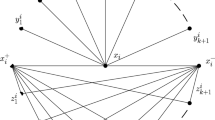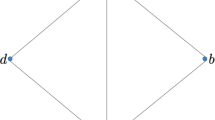Abstract
The minimum cut problem, MC, and the special case of the vertex separator problem, consists in partitioning the set of nodes of a graph G into k subsets of given sizes in order to minimize the number of edges cut after removing the k-th set. Previous work on approximate solutions uses, in increasing strength and expense: eigenvalue, semidefinite programming, SDP, and doubly nonnegative, DNN, bounding techniques. In this paper, we derive strengthened SDP and DNN relaxations, and we propose a scalable algorithmic approach for efficiently evaluating, theoretically verifiable, both upper and lower bounds. Our stronger relaxations are based on a new gangster set, and we demonstrate how facial reduction, FR, fits in well to allow for regularized relaxations. Moreover, the FR appears to be perfectly well suited for a natural splitting of variables, and thus for the application of splitting methods. Here, we adopt the strictly contractive Peaceman-Rachford splitting method, sPRSM. Further, we bring useful redundant constraints back into the subproblems, and show empirically that this accelerates sPRSM.In addition, we employ new strategies for obtaining lower bounds and upper bounds of the optimal value of MC from approximate iterates of the sPRSM thus aiding in early termination of the algorithm. We compare our approach with others in the literature on random datasets and vertex separator problems. This illustrates the efficiency and robustness of our proposed method.

Similar content being viewed by others
Notes
There are several ways of constructing such a matrix \({\widetilde{V}}\). Another way is presented in (2.45), below.
The name gangster refers to shooting holes in the matrix, a term coined originally by Philippe Toint.
The singularity degree is essentially the minimum number of FR steps needed to find the so-called minimal face, the smallest face containing the feasible set. The singularity degree depends on the data of the problem, i.e., the linear constraints, \({{\mathcal {A}}} (X) = b\), and the semidefinite cone. For the original SDP relaxation before FR, it can be shown that the singularity degree is one, i.e., one can use the lifted linear equality constraints to find an exposing vector and use it to construct the matrix \({\widehat{V}}\).
Robinson regularity: strict feasibility holds and the linear constraints are onto, [23].
There is a misprint error in [29, Lemma 4.1]: the variable Z in item (c) should be Y.
Strict feasibility holds and the linear constraints are onto, [23].
This strengthens [18, Lemma 3.2].
Note that the inner maximization forces \(Y={\widehat{V}} R{\widehat{V}}^T\).
Note that the Lagrangian is linear in R, Y and linear in Z. Moreover, both constraint sets \({{\mathcal {R}}} ,{{\mathcal {Y}}} \) are convex and compact. Therefore, the result also follows from the classical Von Neumann-Fan minmax theorem.
Note that if \(Y^{\text {out}}\) is rank-1 and feasible, then the first two methods in Item 1a and Item 1b yield exact solutions to MC. This motivates the use of eigenvector information.
MATLAB: \(r = \min (\hbox {sum}(\lambda /(n+1)>0.1)+1,n+1)\);
The DNN relaxation in [19] imposes the additional nonnegativity constraints \({\widehat{V}} Z{\widehat{V}}^T\ge 0\) onto their \({\mathbf{SDP}} _{\text {final}}\) relaxation.
Note that our data are integral and we round up the lower bound, therefore the gap is integer valued. Thus, finding a zero duality gap is reasonable. Moreover, the lower bounds are nonnegative.
As pointed out by one reviewer, in this case, we have \(n= k\), and the objective function in (1.1) is the number of nonzero entries that remain in the upper triangular part of \(X^TAX\) after removing the last row and column. Thus, an optimal solution \(X\in {{\mathcal {M}}}_e\) is a permutation matrix that puts the vertex with the highest degree as vertex n. Here, we include these instances to test the effectiveness of our new gangster constraints.
In MATLAB: A = abs(sprandsym(sum(m),densityA))\(>0\); A = A - diag(diag(A)); Note that densityA is different from the density of the graph p defined in Table 1.
These results use extra cutting planes, and therefore they obtain stronger lower bounds on \({{\,{\mathrm{{cut}}}\,}}(m)\).
References
MOSEK ApS. The MOSEK optimization toolbox for MATLAB manual. Version 8.1., (2017). http://docs.mosek.com/8.0/toolbox/index.html
Balas, E., Ceria, S., Cornuejols, G.: A lift-and-project cutting plane algorithm for mixed 0–1 programs. Math. Programm. 58, 295–324 (1993)
Boyd, S., Parikh, N., Chu, E., Peleato, B., Eckstein, J.: Distributed optimization and statistical learning via the alternating direction method of multipliers. Found. Trends Mach. Learn. 3(1), 1–122 (2011)
Bücker, H.M., Rostami, M.A.: Interactively exploring the connection between nested dissection orderings for parallel cholesky factorization and vertex separators. In: 2014 IEEE International Parallel Distributed Processing Symposium Workshops, pp. 1122–1129 (2014)
Chazelle, Bernard: Kingsford, Carl, Singh, Mona: a semidefinite programming approach to side chain positioning with new rounding strategies. INFORMS J. Comput. 16(4), 380–392 (2004)
Chen, Y., Ye, X.: Projection onto a simplex. arXiv preprint. arXiv:1101.6081, (2011)
Cornaz, D., Magnouche, Y., Mahjoub, A.R., Martin, S.: The multi-terminal vertex separator problem: polyhedral analysis and branch-and-cut. Dis. Appl. Math. 256, 11–37 (2019)
Didi Biha, M., Meurs, M.-J.: An exact algorithm for solving the vertex separator problem. J. Global Optim. 49(3), 425–434 (2011)
George, Alan, Gilbert, John R., Liu, Joseph W.H.: Graph theory and sparse matrix computation, vol. 56. Springer, Berlin (2012)
Hager, W.W., Hungerford, J.T., Safro, I.: A multilevel bilinear programming algorithm for the vertex separator problem. Comput. Optim. Appl. 69(1), 189–223 (2018)
He, B., Liu, H., Wang, Z., Yuan, X.: A strictly contractive Peaceman-Rachford splitting method for convex programming. SIAM J. Optim. 24(3), 1011–1040 (2014)
He, Bingsheng: Ma, Feng, Yuan, Xiaoming: convergence study on the symmetric version of ADMM with larger step sizes. SIAM J. Imag. Sci. 9(3), 1467–1501 (2016)
Kingsford, Carleton L.: Chazelle, Bernard, Singh, Mona: Solving and analyzing side-chain positioning problems using linear and integer programming. Bioinformatics 21(7), 1028–1039 (2005)
Lara, Carlos, Flores, Juan J., Calderon, Felix: On the hyperbox-hyperplane intersection problem. INFOCOMP J. Comp. Sci. 8(4), 21–27 (2009)
Lewis, R.H.: Yet another graph partitioning problem is NP-hard. Technical report, (2014)
Lovász, L., Schrijver, A.: Cones of matrices and set-functions and 0–1 optimization. SIAM J. Optim. 1(2), 166–190 (1991)
Maculan, N., Santiago, C.P., Macambira, E.M., Jardim, M.H.C.: An \(O(n)\) algorithm for projecting a vector on the intersection of a hyperplane and a box in \({\mathbb{R}}^n\). J. Optim. Theory Appl. 117(3), 553–574 (2003)
Oliveira, D.E., Wolkowicz, H., Xu, Y.: ADMM for the SDP relaxation of the QAP. Math. Program. Comput. 10(4), 631–658 (2018)
Pong, T.K., Sun, H., Wang, N., Wolkowicz, H.: Eigenvalue, quadratic programming, and semidefinite programming relaxations for a cut minimization problem. Comput. Optim. Appl. 63(2), 333–364 (2016)
Pothen, A.: Graph partitioning algorithms with applications to scientific computing. In: Keyes, D.E., Sameh, A., Venkatakrishnan, V. (eds.) Parallel Numerical Algorithms. ICASE/LaRC Interdisciplinary Series in Science and Engineering, vol. 4, pp. 323–368. Kluwer Academic Press, Dordrecht (1997)
Rendl, F., Lisser, A., Piacentini, M.: Bandwidth, vertex separators and eigenvalue optimization. In: Bezdek, K., Deza, A., Ye, Y. (eds.) Discrete Geometry and Optimization. Fields Institute Communications, vol. 69, pp. 29–263. Springer (2013)
Rendl, F., Sotirov, R.: The min-cut and vertex separator problem. Comput. Optim. Appl. 69(1), 159–187 (2018)
Robinson, S.M.: Regularity and stability for convex multivalued functions. Math. Oper. Res. 1, 130–143 (1976)
Rockafellar, R.T.: Convex analysis. Princeton Landmarks in Mathematics. Princeton University Press, Princeton, NJ, 1997. Reprint of the 1970 original, Princeton Paperbacks
Sherali, H.D., Adams, W.P.: Computational advances using the reformulation-linearization technique (RLT) to solve discrete and continuous nonconvex problems. Optima 49, 1–6 (1996)
Simpson, Toby: Sparse cholesky reordering with the graph \(p\)-laplacian. Master’s thesis, Universitá della Svizzera Italiana, (2017)
Sun, H.: ADMM for SDP relaxation of GP. Master’s thesis, University of Waterloo, (2016)
van den Berg, E., Friedlander, M.P.: Probing the Pareto frontier for basis pursuit solutions. SIAM J. Sci. Comput. 31(2), 890–912 (2008)
Wolkowicz, H., Zhao, Q.: Semidefinite programming relaxations for the graph partitioning problem. Discrete Appl. Math., 96/97:461–479, 1999. Selected for the special Editors’ Choice, Edition (1999)
Zhao, Q.: Semidefinite Programming for Assignment and Partitioning Problems. PhD thesis, University of Waterloo, (1996)
Zhao, Q., Karisch, S.E., Rendl, F., Wolkowicz, H.: Semidefinite programming relaxations for the quadratic assignment problem. J. Comb. Optim. 2, 71–109 (1998)
Author information
Authors and Affiliations
Corresponding author
Additional information
Publisher's Note
Springer Nature remains neutral with regard to jurisdictional claims in published maps and institutional affiliations.
This paper is partially based on the Master′s thesis of Hao Sun [27]. The authors Hao Sun and Henry Wolkowicz thank the Natural Sciences and Engineering Research Council of Canada for their support. Xinxin Li′s research was supported by the National Natural Science Foundation of China (No. 11601183, No. 61872162), Natural Science Foundation for Young Scientist of Jilin Province (No. 20180520212JH) and the China Scholarship Council (No. 201806175127). Ting Kei Pong′s research was supported partly by Hong Kong Research Grants Council PolyU153004/18p.
Rights and permissions
About this article
Cite this article
Li, X., Pong, T.K., Sun, H. et al. A strictly contractive Peaceman-Rachford splitting method for the doubly nonnegative relaxation of the minimum cut problem. Comput Optim Appl 78, 853–891 (2021). https://doi.org/10.1007/s10589-020-00261-4
Received:
Accepted:
Published:
Issue Date:
DOI: https://doi.org/10.1007/s10589-020-00261-4
Keywords
- Semidefinite relaxation
- Doubly nonnegative relaxation
- Min-cut
- Graph partitioning
- Vertex separator
- Peaceman-Rachford splitting method
- Facial reduction




